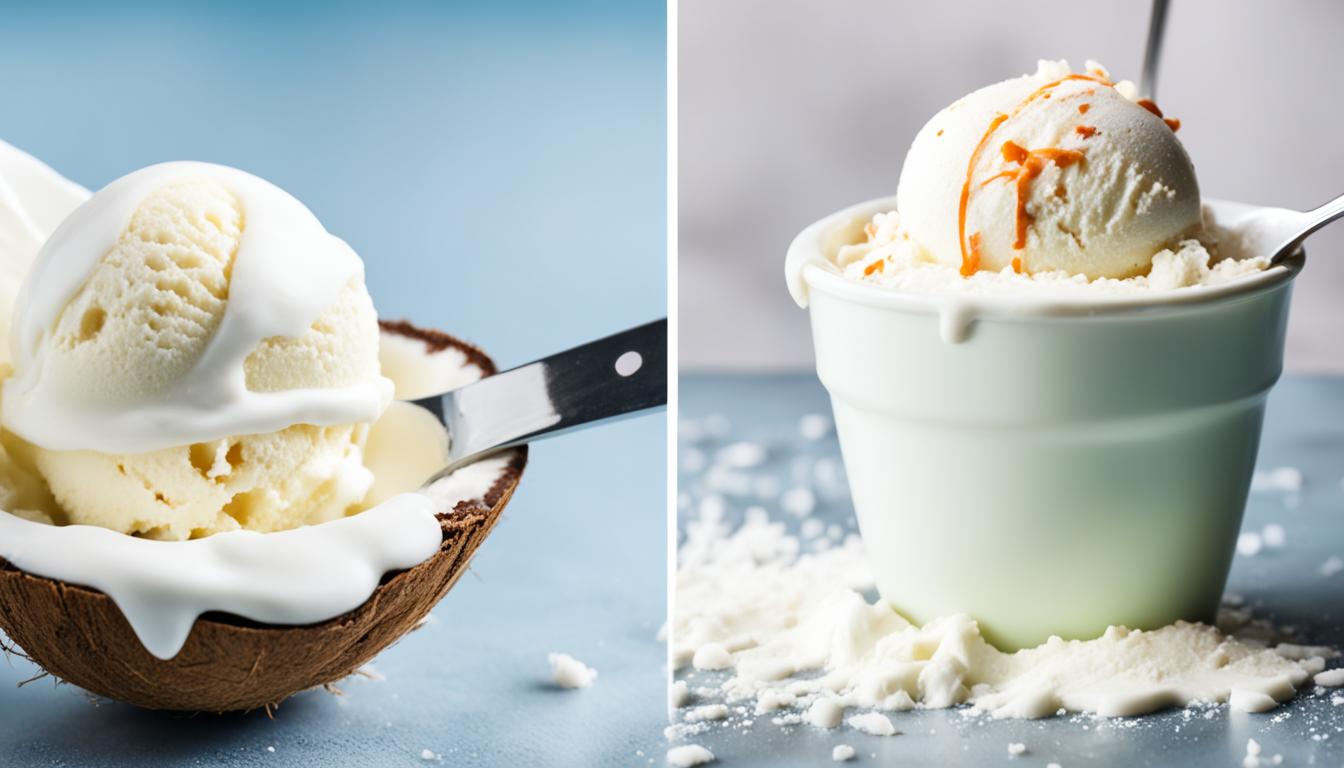Think back to those hot summer afternoons when a scoop of ice cream was the highlight of your day. The delightful feeling of creamy flavors melting in your mouth often reminds you of carefree moments, laughter, and the joy of indulgence. Yet, have you ever pondered the question, “Is ice cream dairy?” With numerous ice cream brands on grocery shelves, the ingredients can sometimes be bewildering. Understanding the relationship between ice cream and dairy becomes essential, especially as you aim for a healthier lifestyle and become increasingly mindful of what goes into your food. In this article, we’ll explore the composition of ice cream while addressing the evolving perceptions and realities around dairy content in ice cream.
Key Takeaways
- Ice cream must legally contain certain levels of milk protein and dairy fat to be classified as dairy.
- The rise of dairy-free options offers alternatives for those seeking to avoid dairy products.
- Understanding the ingredients can help you make informed choices about your favorite frozen desserts.
- Many commercial ice creams contain cheaper fillers to enhance volume without increasing costs.
- Current trends in ice cream production are leading to innovative options, including protein-enriched frozen treats.
Understanding Ice Cream Composition
When pondering the composition of ice cream, you might think about the creamy texture and delightful flavors that make it a favorite treat. Essentially, what is ice cream made of? The primary ingredients include cream, sugar, and various flavorings. The smooth consistency depends significantly on the quality of these components and the method used to create them.
Ice cream must contain a minimum of 10% milk fat to be classified as such. If the fat content falls below this threshold, it transitions into categories like “ice milk” or “low fat” ice cream. Premium ice creams generally contain between 11% to 15% butterfat, while super-premium options boast even higher fat levels, reaching up to 18%.
In addition to dairy, ice cream ingredients can include stabilizers and emulsifiers, which help enhance texture and prolong shelf life. The use of rock salt in the ice-cream making process is quite popular as it lowers the melting point of ice, allowing for quicker freezing and resulting in smaller ice crystals. This method results in creamier ice cream that is more enjoyable to eat.
For those curious about innovative techniques, liquid nitrogen and dry ice have paved the way for modern ice cream-making. Treats such as Dippin Dots take advantage of these methods, creating small, frozen spheres of ice cream that melt in your mouth. It’s fascinating how much variety exists in the world of ice cream, with thousands of sweet and savory flavors designed to meet diverse consumer tastes.

A noteworthy aspect of ice cream is storage. To retain the best flavor and texture, it is advisable to consume it within a month of purchase. Storing ice cream in the main compartment of the freezer, as opposed to the door, minimizes thaw and refreeze cycles that can degrade texture quality. Additionally, it is important to keep the container tightly sealed to prevent ice crystals from forming, which can negatively impact both flavor and texture. For homemade varieties, knowing how long to churn ice cream is crucial, as over-churning can lead to an overly firm texture, while under-churning may result in a lack of smoothness. A good guideline is to churn until the ice cream reaches a soft-serve consistency before freezing it for further firming.
Here is a concise breakdown of ice cream types based on their composition:
| Type of Ice Cream | Milk Fat Content (%) | Notes |
|---|---|---|
| Regular Ice Cream | 10-11% | 90-100% overrun |
| Premium Ice Cream | 11-15% | Higher quality ingredients |
| Super-Premium Ice Cream | 14-18% | Less than 50% overrun |
| Frozen Custard | Minimum 10% | Includes 1.4% egg yolk solids |
| Sherbet | 1-2% | Lower milkfat content |
| Gelato | Lower than traditional ice cream | Denser and creamier texture |
The ongoing evolution of ice cream ingredients continues to fascinate enthusiasts and casual consumers alike. Understanding these factors enhances your appreciation of this beloved dessert.
What Makes Ice Cream Dairy?
Determining what makes ice cream dairy hinges on its ingredients. The dairy ice cream definition revolves around specific requirements for milk content. According to federal regulations, ice cream must contain at least 10% milkfat. This precise criterion helps classify a product as dairy ice cream.

In addition to the milkfat, ice cream must incorporate a minimum of 2.5% milk protein for its composition to qualify as dairy. These specifications ensure that various dairy products in ice cream create the rich and creamy texture consumers expect. Furthermore, products labeled as gourmet or super-premium ice creams often contain 12% or more milkfat, elevating their richness.
The process of making ice cream involves critical steps that affect its quality. Firstly, combining the ingredients creates a mix that is then aerated during freezing, a factor known as “overrun.” This technique increases the volume and contributes to a smoother texture. The mix also encounters significant pressure in the homogenizer, averaging around 2000 pounds per square inch to ensure milkfat particles break down efficiently.
When considering what makes a product dairy ice cream, note that it must not weigh less than 4.5 pounds per gallon. The mix is subsequently quick-cooled and then frozen, either through a “continuous freezer” or a “batch freezer” method. Attention to detail during these stages is crucial for achieving the desired outcome in dairy ice creams. This intricate balance of ingredients and processes defines what makes ice cream dairy, establishing a clear distinction from non-dairy options.
Dairy Content in Ice Cream
When it comes to determining the dairy content ice cream, not all products are created equal. Federal standards dictate that ice cream must have a minimum of 10% milk fat and 20% total milk solids by weight. This means that many commercially available ice creams may contain varying levels of dairy, leading to a spectrum of ice cream dairy percentages across different brands.
For instance, premium ice creams can boast upwards of 16% milk fat, providing a richer and creamier texture. In contrast, reduced-fat ice cream must contain at least 25% less fat than its full-fat counterpart. Low-fat ice cream features 3 grams or less of fat per serving, while light ice cream has at least 50% less fat. For those looking for a very low-fat option, fat-free ice cream contains less than 0.5 grams of fat per serving.
Interestingly, products like sherbet only contain between 1 to 2% milk fat and 2 to 5% total milk solids, indicating a significantly lower dairy content ice cream. Frozen yogurt, on the other hand, lacks specific standards, which results in great variability in ingredients and characteristics.
Understanding how much dairy in ice cream can greatly affect nutritional considerations. Nutritional value varies with the type of milk used and any additional ingredients like cream or egg yolk solids. For instance, a 1/2 cup serving of vanilla ice cream typically contains around 137 calories, 7.0g of fat, and 3g of protein. In comparison, light vanilla ice cream has the same caloric content but offers a reduced fat content.

Is Ice Cream Dairy? Exploring the Ingredients
Understanding the primary ice cream ingredients helps clarify the debate surrounding whether ice cream qualifies as a dairy product. The role of milk proteins and fats in creating that beloved creamy texture cannot be overstated. High-quality ice cream typically contains significant amounts of these components, which enhance flavor and mouthfeel. Economic considerations, however, have prompted many manufacturers to explore alternative ingredients in ice cream.
Milk Proteins and Fats
Milk fats in ice cream are essential for achieving the desired richness. Most premium brands often feature up to 14 percent milk fat to create that indulgent experience you crave. Ice cream must adhere to certain standards, such as containing a minimum of 10 percent milk fat and 6 percent non-fat milk solids according to USDA guidelines. These regulations help maintain quality while ensuring authenticity.
Alternative Ingredients
As the market evolves, many brands are substituting traditional components with alternative ingredients in ice cream like whey solids and various plant-based fats. This adaptation aims to cater to consumers’ changing preferences and dietary needs. Options like almond, coconut, or soy milk offer viable dairy-free alternatives that appeal to lactose-intolerant or vegan consumers. With the ice cream market projected to reach $91 billion by year-end, brands are keen to innovate while making informed choices about the ingredients they use.

Dairy vs Non-Dairy Ice Cream Options
The market for ice cream has expanded significantly with numerous dairy vs non-dairy ice cream options ahora available. You can find health food stores and retailers with over 30 different non-dairy ice cream choices, making it easier than ever to explore variety. This growth aligns with rising awareness of lactose intolerance, dietary preferences, and ethical concerns surrounding dairy production.
Non-dairy ice cream typically uses plant-based ingredients such as almond, coconut, or soy milk. These alternatives can mimic the texture and flavor of traditional dairy ice cream. For instance, So Delicious’ Creamy Vanilla soy milk option contains just 120 calories and 0 grams of saturated fat per half-cup serving, offering a healthier choice for those watching their dietary intake. In comparison, Breyer’s “traditional” dairy-based vanilla ice cream provides 170 calories and 6 grams of saturated fat in the same serving size.

As consumer preferences shift, the non-dairy frozen dessert market is projected to grow to $8.7 billion by 2028. This trend is driven by a desire for dairy-free ice cream options that align with health trends and ethical considerations. For example, Halo Top offers dairy-free ice cream with only 70 to 90 calories per half-cup serving, significantly lower than some coconut-based options, which can soar to over 240 calories.
| Brand | Type | Calories (per half-cup) | Saturated Fat (grams) | Sugar (grams) |
|---|---|---|---|---|
| So Delicious | Creamy Vanilla Soy Milk | 120 | 0 | 10 |
| Breyer’s | Dairy Vanilla | 170 | 6 | 19 |
| Halo Top | Dairy-Free | 70-90 | 1-3 | 7-8 |
| Cosmic Bliss | Coconut-Madagascar Vanilla Bean | 250 | 18 | 13 |
| Nondairy Ben & Jerry’s | Assorted Flavors | 240 | 8 | 24 |
Understanding the variety of non-dairy ice cream choices allows you to make informed decisions. While some options may have higher calories or saturated fat, many brands focus on health-conscious recipes, contributing to the growing popularity of dairy-free alternatives. This shift not only benefits individual health but also responds to growing environmental concerns related to dairy farming.
The Rise of Dairy-Free Ice Cream
The demand for dairy-free ice cream is on the rise, reflecting a significant shift in consumer preferences toward healthier options and cruelty-free products. As more people become aware of dietary needs and ethical concerns, the popularity of dairy-free ice cream continues to grow. This segment of the market showcases a variety of appealing flavors and ingredients, with notable interest in plant-based choices.
Popular Dairy-Free Alternatives
Dairy-free alternatives make it easy for consumers to indulge without compromising their dietary choices. Some of the most sought-after options include:
- Coconut milk ice cream
- Almond milk ice cream
- Cashew-based options
- Oat and soy milk ice cream
These alternatives not only satisfy cravings but also contribute to the growing dairy-free ice cream popularity among health-conscious individuals. The variety available opens the door for diverse flavor profiles, encouraging more consumers to explore non-dairy choices.
Nutritional Benefits of Dairy-Free Options
The benefits of dairy-free ice cream extend beyond just being a substitute for traditional ice cream. Many dairy-free products offer improved nutritional profiles, including:
- Lower calories compared to conventional ice cream
- Reduced saturated fats
- Increased dietary fiber from plant-based ingredients
- Fewer allergens for those who are lactose intolerant or have Celiac disease
These factors provide strong incentives for consumers to choose dairy-free options. An increasing number of individuals, including children and adults, are affected by lactose intolerance, which has propelled interest in dairy-free ice cream. Brands like Eclipse ice cream are leading the way with innovative recipes that use ingredients like oat, corn, and potato, offering delicious alternatives without sacrificing taste.

As awareness regarding dairy-free benefits continues to grow, the market for these alternatives is projected to expand significantly, with an estimated value of $1.2 billion by 2025. The shift toward plant-based ice creams not only supports a healthier lifestyle but also contributes to a more sustainable food culture.
Dairy Ingredients in Ice Cream
When diving into the world of dairy ingredients in ice cream, it’s crucial to understand that approximately 70% of ice cream components stem from milk. This significant dairy content plays a vital role in defining the overall flavor and texture of your favorite frozen treat. Common ingredients like cream, butter, and milk fat directly contribute to the richness and creaminess that are highly sought after.

Non-fat milk solids also contribute to the body and smoothness of ice cream. These components are not just fillers; they deliver essential proteins and vitamins beneficial to your diet. Sweetening agents like cane sugar or glucose syrups are added to enhance flavor while helping to moderate freezing and melting temperatures.
It’s important to note that flavors in ice cream vary widely, ranging from classic options like chocolate and vanilla to more extravagant mixes involving fruits and liqueurs. Additionally, commercial ice cream includes stabilizers and emulsifiers, which serve to control ice crystal size, maintain consistency, and evenly distribute milk fat. Stabilizers approved by Food Standards Australia and New Zealand help achieve a unique texture that enhances the overall eating experience.
Naturally, identifying dairy in ice cream extends beyond the milk and cream. While no preservatives are added, the role of dairy proteins cannot be overlooked. These proteins enhance the ice cream’s body and texture while improving visual appeal by creating opacity and a milky appearance.
With rising consumer interest in nutrition, brands have started launching ice creams with added protein to meet health demands without compromising on taste. By understanding these various components, you can make informed choices about the ice cream products that best fit your preferences for quality and nutrition.
Understanding Dairy Products in Ice Cream Manufacturing
Ice cream manufacturing relies heavily on various dairy products that formulate its rich and creamy texture. Understanding these dairy components not only informs you about the ice cream you consume but also sheds light on the complexities of the production process. In this section, you will discover the essential dairy products in ice cream manufacturing and how fillers in ice cream interact with these ingredients.
Common Dairy Components
The foundation of ice cream lies in its dairy products, which include:
- Milk: A vital source of fat and protein.
- Cream: Usually contributes to a richer taste and creamier texture due to its higher fat content.
- Butterfat: Enhances flavor and mouthfeel, helping achieve that signature ice cream texture.
- Dairy-derived stabilizers: Such as alginates and gums, which assist in maintaining texture and preventing ice crystallization.
These dairy components play pivotal roles, with ice cream typically requiring a minimum of 10% milk fat and 20% total milk solids to qualify as ice cream. Premium ice creams often boast higher fat content, enriching both taste and texture.
The Role of Fillers and Bulking Agents
To maximize profits, manufacturers sometimes resort to fillers in ice cream, which can include synthetic emulsifiers and vegetable oils. These alternative ingredients can mimic the texture of dairy components but may influence the perceived authenticity and quality of the product. Common practices include:
- Incorporating nonfat solids, which can range between 9% to 12%, to aid texture without adding cream.
- Employing stabilizers and emulsifiers that help control the incorporation of air during the freezing process.
- Reducing costs by using sweeteners like corn syrups, which can replace some sugar in the formulation.
You may find it surprising that a significant portion of the ice cream’s volume can be air, known as overrun. While ice cream commonly has an overrun of up to 100%, premium alternatives tend to have less, resulting in dense and indulgent products.

The Impact of Dairy Farming on Ice Cream Production
The intersection of dairy farming and ice cream production presents a landscape filled with both economic opportunities and pressing environmental challenges. Dairy farming, while essential for the creation of beloved treats, brings with it significant impacts that warrant attention. Understanding the dairy farming impact on ice cream helps you make informed choices and fosters deeper insights into your food sources.

The economic contributions of the dairy industry are substantial, supporting approximately 3.2 million jobs across the country. This includes over 27,000 direct jobs stemming from ice cream production, which contributes around $11.4 billion to the economy. That’s a considerable figure when you think about how much ice cream is enjoyed nationwide. In fact, about 73% of Americans indulge in ice cream at least once a week.
While the economic benefits are undeniable, the environmental effects of dairy farming can be quite severe. Traditional practices often lead to resource depletion, including deforestation and pollution of waterways. These issues prove detrimental to local ecosystems and threaten biodiversity. Increased awareness of these environmental effects drives some consumers toward ice cream production sustainability, shaping choices that prioritize a healthier planet.
- Animal welfare: Intensive breeding practices raise concerns about the treatment of dairy animals.
- Greenhouse gas emissions: Dairy farming has a significant carbon footprint, contributing to climate change.
- Water use: Dairy production is water-intensive, raising challenges related to water scarcity in some regions.
By recognizing both the economic importance and the environmental implications of dairy farming, you can play a role in promoting better practices. Supporting brands committed to sustainability and ethical farming can enhance the overall industry standards, making it easier to enjoy your favorite ice cream flavors without compromising the planet’s health. Every scoop can contribute not just to the economy but also to the future of sustainable practices in food production.
Consumer Choices: Dairy or Dairy-Free?
As you navigate the extensive ice cream market, your preference between dairy and dairy-free options speaks volumes about your values. Making choices dairy vs dairy-free often reflects your considerations surrounding health, ethics, and environmental impact. Increased transparency in product labeling has elevated the awareness of ingredient sourcing, prompting more individuals to explore dairy-free alternatives. This trend highlights a significant shift in consumer preferences ice cream.
During recent years, there has been notable growth in the demand for dairy-free products. According to statistics, the global plant-based food market is projected to reach a staggering $74.2 billion by 2027. This surge points to changing consumer attitudes, with approximately 56 percent of consumers maintaining their dairy milk purchases, despite rising prices. It showcases that taste remains a critical factor for 70 percent of consumers.
For those interested in selecting ice cream options, the challenge often lies in balancing flavor with nutritional value. A prominent 1 in 2 US consumers express a desire for more innovative dairy-free ice cream varieties that boast unique mix-ins or inclusions. Additionally, 31 percent of US adults purchasing frozen treats wish for non-dairy options to be just as indulgent as their dairy-based counterparts. Consumers seem eager for choices that not only cater to their taste buds but also align with their dietary needs.
As younger generations like Gen Z increasingly aim to reduce their consumption of animal products, the landscape of consumer preferences ice cream continues to evolve. Adopting a more responsible diet, with 52 percent of Gen Z working to cut down on meat and dairy, confirms this paradigm shift. With participation in initiatives such as Veganuary doubling each year, more people recognize the value of dairy alternatives.

| Consumer Preferences | Dairy | Dairy-Free |
|---|---|---|
| Pursuit of Innovative Flavors | Often standard flavors | High demand for unique options |
| Health-Driven Choices | 70% cite taste as important | 42% motivated by health |
| Sustainability Considerations | Less emphasis on sustainability | 53% prioritize eco-friendly options |
| Market Growth | Stable, minor fluctuations | Significant growth projected |
As you continue your journey in selecting ice cream options, consider how your choices align with both personal and broader societal goals. The decision-making process around making choices dairy vs dairy-free is more than a simple preference; it intertwines with health, sustainability, and social consciousness.
Conclusion
In summary, understanding ice cream’s dairy content involves exploring a variety of elements from the ingredients used to the broader implications of your ice cream choices. While traditional dairy ice cream boasts its share of nutrients, it’s classified as an ultra-processed food, high in calories, fat, and sugar, which can contribute to health concerns like type 2 diabetes and cardiovascular diseases. However, emerging research has shown that those who indulge in ice cream in moderation—no more than twice a week—could experience potential cardiovascular benefits, highlighting a nuanced relationship between your dietary choices and health.
Final thoughts on dairy-free options are crucial as well. With the growing awareness of dietary needs, many are choosing dairy-free alternatives that can provide similar flavors without the associated health risks. These options also cater to those with lactose intolerance or ethical concerns regarding dairy farming practices. Understanding the implications of your ice cream choices is vital in making informed decisions about what goes into your body.
The ice cream landscape is continuously evolving, offering diverse alternatives that can suit a range of dietary preferences and health goals. Whether you lean towards traditional dairy or explore plant-based options, being informed about ice cream’s dairy content and potential health effects enables you to enjoy this beloved treat responsibly.










